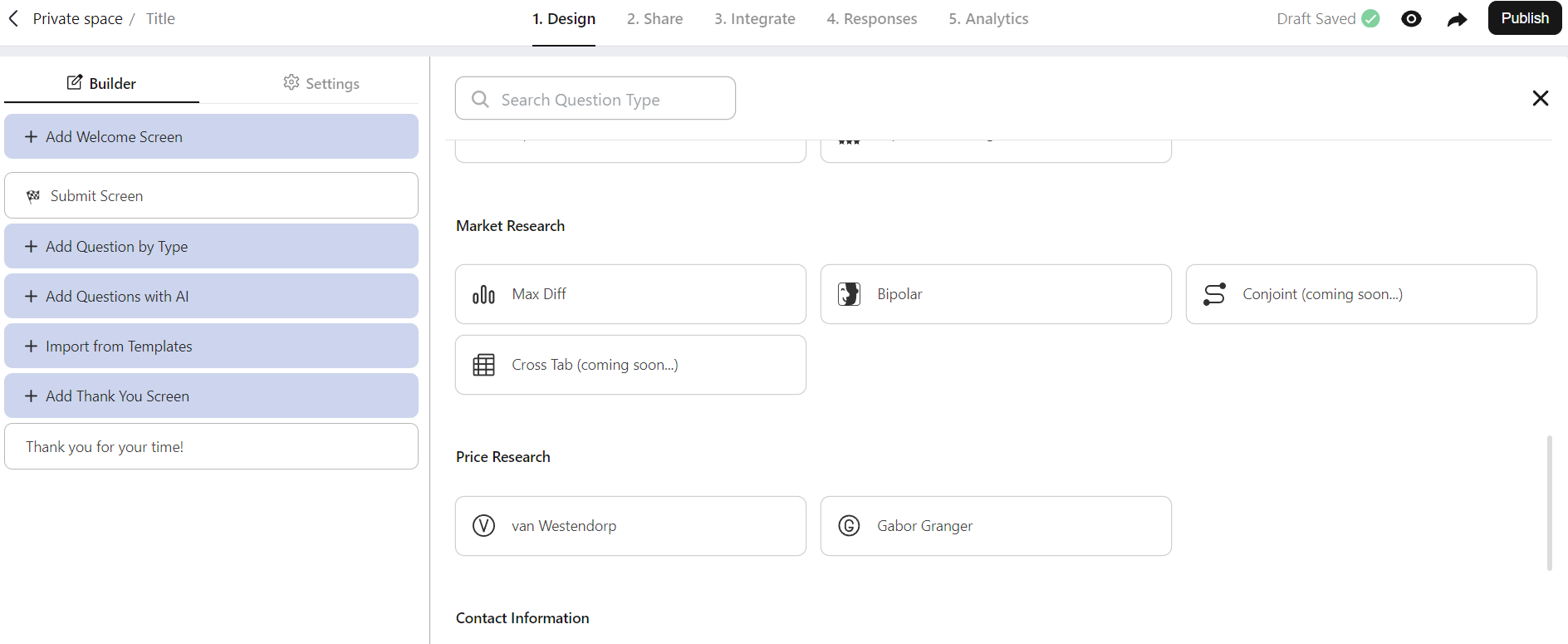Get insights.
Unlock value.
- 14-day free trial
- Set up in minutes
- No credit card required
Gabor Granger Pricing Scale
Introduction
In the world of business, setting the right price is like finding the perfect balance on a seesaw – it requires finesse. Enter the Gabor-Granger Pricing Scale, a clever tool that helps businesses understand what price makes customers say, "Yes, I'll take it!" This technique isn't about complicated jargon; it's about simple, practical solutions for businesses of all shapes and sizes.
The Gabor Granger Pricing Scale is a pricing analysis technique that helps businesses into understanding not just what consumers are willing to pay but also helps in establishing a relationship between different price points and consumer demand elasticity.. In this blog, we will explore the Gabor Granger Pricing Scale component and understand how it can be effectively applied in the world of business.
How to set up your Gabor Granger component in BlockSurvey?
Simple and straightforward, just follow the steps given below,
Add Gabor Granger question type from the Pricing Research group of components.

Add appropriate question label and description based on your product/service.
Next would be setting the Gabor Granger Labels. These Labels include a sub question label, Yes button label, No button label, Currency label, and a label providing additional price details.

You may alter them or leave them as such.
Next you may set the pricing ranges i.e. set minimum and maximum prices for your product/service and also adjust the value to increment the prices. Default values are minimum price - 10, maximum price - 50, increment by - 10.
Your Gabor Granger component is all ready and set to roll.
How is the survey taken?
Now, the Gabor Granger component in BlockSurvey is a set of of price points which flash on the survey taking screen until the highest price point acceptable to the respondent is chosen.
How do you interpret the results
Once the survey data is collected, the responses are plotted on a graph, the graph contains two curves:
- Demand Curve/Willingness to Pay: This curve is built by plotting the cumulative percentage of respondents who are willing to purchase at each price point. A sharp decline from one point to another means the price elasticity is very high.
- Revenue Curve: The revenue curve maps expected revenue based on the number of respondents willing to purchase at each price point. Each point is calculated by taking the price point multiplied by the respondent's willingness to buy.
Based on the analysis, the following can be found out,

The Revenue Curve can be used to find the Revenue Maximizing Price Point. This is the price point that would result in the highest total revenue.
The Demand Curve can be used to find the Price Elastic Values which measures how price changes will affect demand.
- Elastic demand curves indicate that the quantity demanded responds to price changes in a greater than proportional manner.
- An inelastic demand curve is one where a given percentage change in price will cause a smaller percentage change in quantity demanded.
- Unitary elasticity means that a given percentage change in price leads to an equal percentage change in quantity demanded.
Advantages of the Gabor Granger Pricing Scale
- Quantitative Insights into Price Sensitivity: Gabor-Granger provides a quantitative understanding of consumer price sensitivity. By collecting data through surveys and experiments, businesses can analyze the relationship between price changes and consumer demand.
- Calculation of Price Elasticity: One of the strengths of the Gabor-Granger technique is its ability to calculate price elasticity. This metric is crucial for understanding how changes in price affect the quantity demanded.
- Competitor Benchmarking: Gabor-Granger incorporates an understanding of competitor pricing, allowing businesses to benchmark their prices against industry rivals.
- Adaptability to Market Changes: Markets are dynamic, and consumer preferences can shift. The Gabor-Granger technique provides a framework for continuous monitoring and adaptation.
Conclusion
The Gabor-Granger pricing scale offers a holistic and data-driven approach to pricing, empowering businesses to make strategic decisions that align with consumer preferences and market dynamics. By leveraging its advantages, companies can optimize their pricing strategies for long-term success in a competitive business environment.
Gabor Granger Pricing Scale FAQ
What is the Gabor Granger Pricing Scale?
The Gabor Granger Pricing Scale is a market research tool used to determine consumer price sensitivity for a product or service.
How does the Gabor Granger Pricing Scale work?
The scale involves presenting potential customers with different price points and asking them if they would be willing to purchase the product or service at each price level. The data collected helps businesses understand consumer demand at various price points.
What is the benefit of using the Gabor Granger Pricing Scale?
By using this scale, businesses can gain insights into price sensitivity, identify optimal price points, and make informed pricing decisions to maximize profits.
Can the Gabor Granger Pricing Scale be applied to different industries?
Yes, the scale is applicable to various industries, including both products and services, making it a versatile tool in market research.
Get insights.
Unlock value.
- 14-day free trial
- Set up in minutes
- No credit card required
